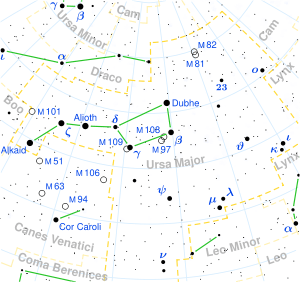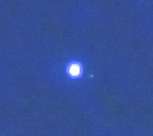Alpha Ursae Majoris

| |
| Observation data Epoch J2000 Equinox J2000 | |
|---|---|
| Constellation | Ursa Major |
| Right ascension | 11h 03m 43.67152s[1] |
| Declination | +61° 45′ 03.7249″[1] |
| Apparent magnitude (V) | 1.79[2] |
| Characteristics | |
| Spectral type | K0III[3] + F0V[4] |
| U−B color index | +0.93[2] |
| B−V color index | +1.07[2] |
| Variable type | Suspected[5] |
| Astrometry | |
| Radial velocity (Rv) | –9[6] km/s |
| Proper motion (μ) | RA: –134.11[1] mas/yr Dec.: –34.70[1] mas/yr |
| Parallax (π) | 26.54 ± 0.48[1] mas |
| Distance | 123 ± 2 ly (37.7 ± 0.7 pc) |
| Absolute magnitude (MV) | –1.10 ± 0.04[7] |
| Orbit[4] | |
| Companion | α UMa B |
| Period (P) | 44.4 yr |
| Semi-major axis (a) | 0.603" |
| Eccentricity (e) | 0.4 |
| Inclination (i) | 180° |
| Longitude of the node (Ω) | 2000° |
| Periastron epoch (T) | 1958.000 |
| Details | |
| α UMa A | |
| Mass | 4.25[3] M☉ |
| Luminosity | 316[3] L☉ |
| Surface gravity (log g) | 2.46[8] cgs |
| Temperature | 4,660[8] K |
| Metallicity [Fe/H] | –0.20 ± 0.07[8] dex |
| Rotational velocity (v sin i) | 2.6 ± 1.0[7] km/s |
| α UMa B | |
| Mass | ~1.6[3] M☉ |
| Other designations | |
| Database references | |
| SIMBAD | data |
Alpha Ursae Majoris (α Ursae Majoris, abbreviated Alpha UMa, α UMa), also named Dubhe,[10] is (despite being designated 'alpha') the second-brightest star in the constellation of Ursa Major.
Description

Alpha Ursae Majoris forms part of the Big Dipper (also known as the Plough or the Great Bear), and is the northern of the 'pointers' (or 'guards'), the two stars of Ursa Major which point towards Polaris, the North Star. Dubhe is about 123 light years from the Sun and is a giant star that has evolved away from the main sequence after consuming the hydrogen at its core. It is a spectroscopic binary with a main sequence companion α UMa B that has a stellar classification of F0V. The companion star orbits at a mean separation of about 23 astronomical units (AU) and completes an orbit every 44.4 years.[4]
There is another spectroscopic binary 8 arc minutes distant, a 7th magnitude pair showing an F8 spectral type. It is sometimes referred to as Alpha Ursae majoris C, but is separately catalogued as HD 95638.[4]
α Ursae Majoris has been reported to vary in brightness by about a thousandth of a magnitude. Ten radial oscillation modes have been detected, with periods between 6.4 hours and 6.4 days.[11]
Although it is part of the constellation of Ursa Major, it does not form part of the Ursa Major Moving Group of stars that have a common motion through space.[12]
Nomenclature
α Ursae Majoris (Latinised to Alpha Ursae Majoris) is the star's Bayer designation.
It bore the traditional names Dubhe and Ak. Dubhe derives from the Arabic for 'bear', dubb, from the phrase ظهر الدب الاكبر żahr ad-dubb al-akbar 'the back of the Greater Bear'. The rarer Ak means 'The Eye'.[13] In 2016, the International Astronomical Union organized a Working Group on Star Names (WGSN)[14] to catalog and standardize proper names for stars. The WGSN's first bulletin of July 2016[15] included a table of the first two batches of names approved by the WGSN; which included Dubhe for this star.
The Hindus refer to the star as Kratu, one of the Seven Rishis.[13]
In Chinese, 北斗 Běi Dǒu, meaning Northern Dipper, refers to an asterism consisting of Alpha Ursae Majoris, Beta Ursae Majoris, Gamma Ursae Majoris, Delta Ursae Majoris, Epsilon Ursae Majoris, Zeta Ursae Majoris and Eta Ursae Majoris. Consequently, Alpha Ursae Majoris itself is known as 北斗一 Běi Dǒu yī, (English: the First Star of Northern Dipper) and 天樞 Tiān Shū, (English: Star of Celestial Pivot).[16]
In culture
Dubhe is the official star of the State of Utah. Dubhe was a ship in the United States Navy. The Danish National Home Guard Navy ship MHV 806 is also named Dubhe.
References
- 1 2 3 4 5 van Leeuwen, F. (November 2007). "Validation of the new Hipparcos reduction". Astronomy and Astrophysics. 474 (2): 653–664. arXiv:0708.1752
 . Bibcode:2007A&A...474..653V. doi:10.1051/0004-6361:20078357.
. Bibcode:2007A&A...474..653V. doi:10.1051/0004-6361:20078357. - 1 2 3 Johnson, H. L.; et al. (1966), "UBVRIJKL photometry of the bright stars", Communications of the Lunar and Planetary Laboratory, 4 (99): 99, Bibcode:1966CoLPL...4...99J
- 1 2 3 4 Guenther, D. B.; Demarque, P.; Buzasi, D.; Catanzarite, J.; Laher, R.; Conrow, T.; Kreidl, T. (2000). "Evolutionary Model and Oscillation Frequencies for α Ursae Majoris: A Comparison with Observations". The Astrophysical Journal. 530 (1): L45–L48. Bibcode:2000ApJ...530L..45G. doi:10.1086/312473. PMID 10642202.
- 1 2 3 4 Tokovinin, A. A. (1997). "MSC - a catalogue of physical multiple stars". Astronomy and Astrophysics Supplement Series. 124: 75. Bibcode:1997A&AS..124...75T. doi:10.1051/aas:1997181.
- ↑ Samus, N. N.; Durlevich, O. V.; et al. (2009). "VizieR Online Data Catalog: General Catalogue of Variable Stars (Samus+ 2007-2013)". VizieR On-line Data Catalog: B/gcvs. Originally published in: 2009yCat....102025S. 1. Bibcode:2009yCat....102025S.
- ↑ Wilson, Ralph Elmer (1953), "General catalogue of stellar radial velocities", Washington, Carnegie Institution of Washington, Bibcode:1953GCRV..C......0W
- 1 2 Carney, Bruce W.; et al. (March 2008), "Rotation and Macroturbulence in Metal-Poor Field Red Giant and Red Horizontal Branch Stars", The Astronomical Journal, 135 (3): 892–906, arXiv:0711.4984
 , Bibcode:2008AJ....135..892C, doi:10.1088/0004-6256/135/3/892
, Bibcode:2008AJ....135..892C, doi:10.1088/0004-6256/135/3/892 - 1 2 3 McWilliam, Andrew (December 1990), "High-resolution spectroscopic survey of 671 GK giants. I - Stellar atmosphere parameters and abundances", Astrophysical Journal Supplement Series, 74: 1075–1128, Bibcode:1990ApJS...74.1075M, doi:10.1086/191527
- ↑ "DUBHE -- Spectroscopic binary", SIMBAD, Centre de Données astronomiques de Strasbourg, retrieved 2011-12-23
- ↑ "IAU Catalog of Star Names". Retrieved 28 July 2016.
- ↑ Buzasi, D.; Catanzarite, J.; Laher, R.; Conrow, T.; Shupe, D.; Gautier, T. N.; Kreidl, T.; Everett, D. (2000). "The Detection of Multimodal Oscillations on α Ursae Majoris". The Astrophysical Journal. 532 (2): L133. arXiv:astro-ph/0002512
 . Bibcode:2000ApJ...532L.133B. doi:10.1086/312573. PMID 10715242.
. Bibcode:2000ApJ...532L.133B. doi:10.1086/312573. PMID 10715242. - ↑ Motz, Lloyd; Nathanson, Carol (1988). The Constellations: An Enthusiast's Guide To The Night Sky. Doubleday. p. 39. ISBN 978-0385176002.
- 1 2 Allen, R. H. (1963). Star Names: Their Lore and Meaning (Reprint ed.). New York: Dover Publications Inc. p. 438. ISBN 0-486-21079-0. Retrieved 2012-09-04.
- ↑ "IAU Working Group on Star Names (WGSN)". Retrieved 22 May 2016.
- ↑ "Bulletin of the IAU Working Group on Star Names, No. 1" (PDF). Retrieved 28 July 2016.
- ↑ (Chinese) AEEA (Activities of Exhibition and Education in Astronomy) 天文教育資訊網 2006 年 6 月 15 日